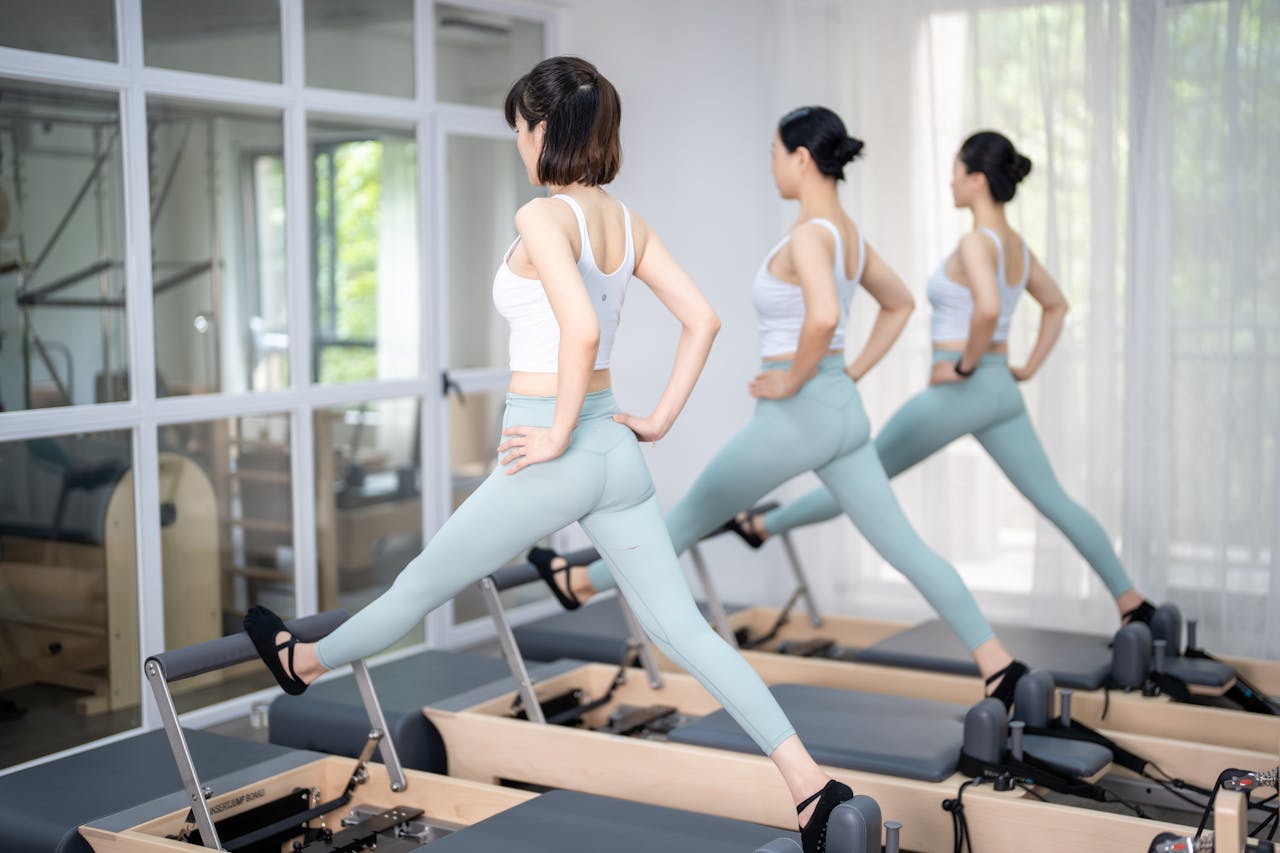
Table of Contents
Pilates Reformer is a form of exercise performed on specialized equipment called a Reformer. Pilates Reformer training focuses on strengthening the body while maintaining proper body alignment. Typically, Pilates Reformer focuses on slow and controlled movements and helps to develop the mind-body connection, improve muscle tone and reach fitness goals.
Key Takeaways
- Definition: A versatile piece of equipment for Pilates workouts.
- Components: Includes a carriage, springs, footbar, straps, and a long box.
- Benefits: Enhances core strength, flexibility, balance, and overall body conditioning.
- Usage: Suitable for all fitness levels and adaptable for rehabilitation.
- Exercise Types: Supports a range of exercises from basic to advanced movements.
- Popularity: Recently purchased by many fitness enthusiasts and studios who absolutely love Pilates for building strength and lose weight.
What is a Pilates Reformer?
The reformer is a piece of equipment used in Pilates practice.
The Pilates reformer helps with many fundamental components of Pilates, including:
- Stretching
- Strengthening
- Body alignment
- Core strength
Pilates reformer was developed by Joseph Pilates and Clara Pilates when they opened their gym in New York City in the 1920s.
Joseph Pilates
Joseph was a competitive gymnast, diver, and skier in his early life and later became a circus performer, boxer, and self-defense instructor.
He started developing his physical fitness techniques during the start of the First World War.
He later worked in the hospital with patients who could not walk due to injuries sustained during fighting.
During this work, Joseph Pilates began to attach bed springs to the hospital beds that allowed him to support the limbs of the patients, which later developed into a piece of equipment called the ‘Cadillac.’
The Cadillac is one of the many pieces of equipment Joseph Pilates developed that are still prevalent today.
In the 1920s, Joseph created his own gym where he created exercises and used special equipment he designed to help with rehabilitation.
Principles of Reformer Pilates
Joseph centered his work around three major principles:
- Breath
- Whole-body health
- Whole-body commitment
- Concentration
- Centering
- Control
- Precision
- Flow
“Above all, learn to breathe correctly.” -Joseph Pilates
Pilates Reformer Machine and Equipment
Reformer Machine
Pilates reformers were initially called the Universal Reformers. The reformer machine is a bed-like frame with a flat platform called the reformer carriage.
The rolling carriage has wheels within the frame and is attached to the frame by springs. These allow for variations in the resistance levels of the person performing certain exercises on the reformer.
The carriage has shoulder blocks or rests, allowing the person on the carriage to perform the exercises without sliding off.
At the end of the reformer is an adjustable bar for one's hand and feet to rest during pilates exercises. On the other side of the reformer, there are long straps that can be pulled with the arms or legs.
The person on the reformer can use their own body weight against the shoulder blocks and with the resistance of the springs to increase or decrease the difficulty of the resistance of the carriage.
The Pilates Reformer offers exercises catering to all fitness levels, allowing for progression and modification as needed.
Additional Equipment
Many other pieces of equipment can be added to the standard reformer or used in conjunction with a pilates reformer during a class.
The Cadillac or trapeze table resembles a four-poster bed connected to the reformer's frame. It has soft straps, a push bar, and a cross-over bar.
These elements serve various purposes, like allowing for hanging, adding resistance, providing support, and allowing for modifications to exercises.
Certain classes may also use a pilates chair in conjunction with the reformer. The chair is a box with a padded seat and pedal attached to the springs. The user may use the chair in either seated or standing; the springs offer tension to increase or decrease the intensity of an exercise.
A Ladder Barrel or Barrel includes a padded barrel, typically with a ladder. These two components are attached to a sliding frame base.
The barrel is a piece of equipment that helps move the spine into flexion and extension and improve the range of moment. It also works to strengthen the core.
Mat Pilates vs. Reformer Pilates
Mat Pilates is generally considered a more flexible and accessible way to practice Pilates; however, Reformer Pilates can add variables you cannot achieve on the mat.
Reformer Pilates is also more effective for injury rehabilitation-focused Pilates than Mat Pilates.
By using the adjustable spring resistance and sliding platform, the Reformer can change the resistance and instability to suit the performer’s ability and challenge them sufficiently.
Additionally, many exercises are only suited for Reformer Pilates.
Pilates Reformer vs. Megaformer
The Pilates Reformer and the Megaformer are machines with similar goals and objectives. However, there are differences which affect the experiences on each machine.
Both machines are similar in that they are beds with springs a sliding bed with straps, and pulleys.
What makes reformer pilates different is that it uses slow and controlled movements, which benefits all ability levels, such as those in rehab, older people, or cross-trainers.
Contrary, Megaformer merges pilates with cardio for a more intense form of exercise. Mageformer classes are high-intensity, low-impact workouts.
Megaformer is a more advanced tool because it involves high-intensity exercises composed of quicker movements. It also uses transitions and exercises performed by standing and sitting.
Benefits of the Pilates Reformer
Pilates Reformer and its movements provide a great workout with many benefits.
These benefits include:
- Improved daily living
- Athletic performance
- Injury prevention
- Recovery
- Overall health
Muscular Strength
Pilates is a type of resistance training focusing on:
- The core and trunk muscles
- Glutes
- Quads
- Hamstrings
- The back and upper body.
The exercises build strength, strengthen lean muscles, and improve bone density by using body weight as resistance and challenging balance.
Reformer exercises specifically provide a unique and varied environment to strengthen muscles.
The exercises promote training with a proper form where the muscles can be strengthened in shortened and lengthened positions.
Balance, Stability, and Posture
Pilates on a Reformer can help to improve balance, stability, and posture. Improved posture can help create a more balanced body and benefit many other health issues.
The Reformer specifically challenges balance, strengthening the core, and improving lower body stability and control.
Core strength and lower body stability are critical for everyday life functions that involve walking, non-linear movements, rotation, or an unstable environment.
The core is responsible for supporting and stabilizing the body. Weakness can lead to hip and back pain, decreased pelvic floor function, and impaired ability to perform explosive movements.
Pilates Reformer training focuses heavily on the body’s alignment and balance of all opposing muscles. This focus on alignment can help build mind-body connection and strengthen some of the stabilizer and postural muscles that aren’t used as frequently.
This focus will help improve posture, which can help alleviate secondary issues related to poor posture, such as imbalanced muscles, poor balance, headaches, upper body, back, or hip pain, and improve ease of movement.
Breathing
Many Pilates Reformer teachers integrate mindful breathing into Pilates movements for heightened body awareness and stress reduction.
Syncing breath with body movements enhances mindfulness, fostering a balanced nervous system.
Athletic Performance
Pilates Reformer has benefits for athletic performance, including:
- Injury prevention
- Recovery
- Increased kinesthetic awareness and proprioception
- Increased strength
- Athleticism.
Focusing on stabilizing the body and increasing flexibility and mobility can help general recovery and improve performance.
The mind-body connection in Pilates helps to increase kinesthetic awareness and proprioception.
This kinesthetic awareness increases the ability to focus on bodily sensations such as pain, emotions, alignment, and the body in relation to its environment and changing variables.
How to Practice Pilates Reformer
Though some home workouts are available for mat pilates, getting good exercise through a pilates reformer is easier with the help of a certified pilates instructor and classes.
Reformers are available for a home gym, though it can be quite an investment. Therefore, trying different pilates reformer classes is most beneficial to determine whether it is practical and the right purchase for the individual.
Many classes have different focuses, ability levels, and target populations. It is best to decide what benefits are more important to the individual, such as strength-based or cardio-based classes.
It is also essential to consider if the individual is recovering from an injury, needs any modifications, or is part of a specific population such as pre and post-natal or osteoporosis; this will affect the class choice.
Reformer classes are typical full-body workouts and have smaller class sizes.
The instructor will help guide participants in setting up their reformer. During the exercises, the instructor will also offer correction and guidance.
It is best to wear comfortable clothes and communicate with the instructor if you need help or assistance with modifications.
It is best to communicate openly with a class instructor and a health care practitioner to ensure the class is suitable for one’s specific needs and to ensure no other injuries happen to get the most benefits out of the class.
Frequently Asked Questions
When Will I See Results from Pilates Reformer?
Like any exercise, consistency is the best way to achieve results.
Staying consistent with Reformer Pilates can provide excellent results if your goals are to build muscle strength and increase flexibility, range of motion, and stability.
Is Reformer Pilates Good for Weight Loss?
Any exercise paired with the right lifestyle choices can result in weight loss if that is your goal.
Compared with mat pilates, reformer pilates was shown to burn more calories than the former. Combining exercise with nutrition is the most effective way to focus on weight loss.
It is always best to discuss weight loss plans with your healthcare provider before making lifestyle changes.
References
Does a Program of Pilates Improve Chronic Non-Specific Low Back Pain? in
Defining Pilates exercise: A systematic review - ScienceDirect
Pilates: What Is It? Should It Be Used in Rehabilitation? - Christine E. Di Lorenzo, 2011
Pilates: how does it work and who needs it? - PMC
Introduction to Pilates-Based Rehabilitation
The Pilates method: history and philosophy - Journal of Bodywork and Movement Therapies
Effects of Pilates Training on Lumbo-Pelvic Stability and Flexibility - PMC
Is Pilates as Good as Everyone Says? - The New York Times
Disclaimer
The contents of this article are provided for informational purposes only and are not intended to substitute for professional medical advice, diagnosis, or treatment. It is always recommended to consult with a qualified healthcare provider before making any health-related changes or if you have any questions or concerns about your health. Anahana is not liable for any errors, omissions, or consequences that may occur from using the information provided.

By: Clint Johnson
Clint is the driving force and founder of Anahana. Clint teaches Yoga, Pilates, mindful breathing, and meditation, catering to a global community of students and teachers.
